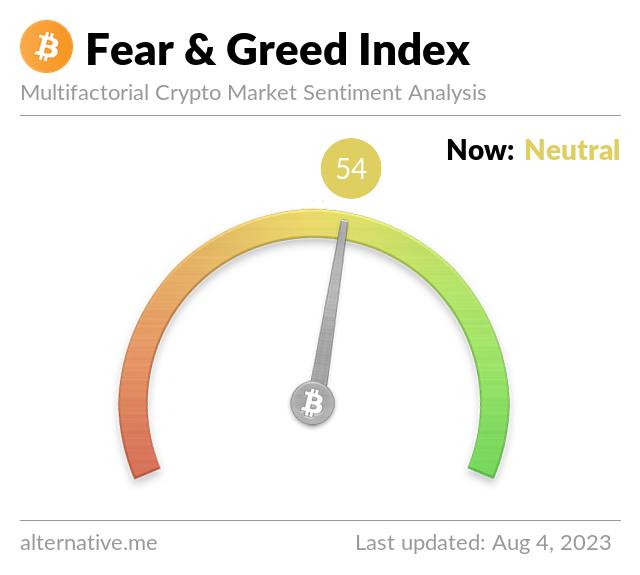Summing Up The Week
While earnings and inflation reports came in positive this week, stocks were thrown a curve ball when the Fitch Ratings Agency lowered its rating on the United States’ debt, causing market turmoil.
Let’s take a look at what news events moved the markets this week…
Market News
Job vacancies and layoffs lower in June
On Tuesday, the Job Openings and Labor Turnover Survey showed openings of 9.58 million in June versus 9.7 million expected and layoffs down to 1.53 million from 1.55 million in May, reported CNBC. On the surface, these numbers are a mixed bag – layoffs decreasing is a sign of a solidifying job market, but lower job openings could indicate potential weakness (even though 9.58 million is still a very high figure).
However, analysts took the report as positive, suggesting that declines in job openings and layoffs indicate a demand for labor that is slowing – which was what the Federal Reserve was hoping for – as companies retain workers while keeping the unemployment rate in check.
Fitch Ratings cuts U.S. debt to AA+ from AAA
Seemingly out of nowhere Tuesday night, Fitch Ratings cut the United States’ long-term debt’s default rating to AA+ from AAA, citing “expected fiscal deterioration over the next three years,” reported CNBC. Fitch pointed to the debate over the debt ceiling in June as reason for concern and stated that the agency expected additional conflict when the debt ceiling deadline comes up in two years.
“In Fitch’s view, there has been a steady deterioration in standards of governance over the last 20 years, including on fiscal and debt matters, notwithstanding the June bipartisan agreement to suspend the debt limit until January 2025,” the ratings agency said. “The repeated debt-limit political standoffs and last-minute resolutions have eroded confidence in fiscal management.”
While the U.S. has been downgraded in the past – the last debt ceiling debate in 2011 prompted Standard & Poor’s to cut the U.S. credit rating – and the fact that Fitch’s downgrade prompted Treasury Secretary Janet Yellen to express her displeasure, the lower rating on U.S. debt didn’t previously present an issue for the Treasury to write bonds and increase the country’s debt.
Bank of England hikes rates 0.25%
Whereas the European Central Bank (ECB) still has a relatively low interest rate of 3.75% after last week’s hike, England’s rate had been 5.00%, pretty close to the United States’, so Thursday’s decision was up in the air. In the end, the Bank of England voted – in a split vote – to hike rates by another quarter point for a 14th consecutive hike, bringing their interest rates to 5.25%, reported CNBC.
Finance Minister Jeremy Hunt noted that headline inflation will be below 3% within a year without the economy slipping into recession, “But that doesn’t mean it’s easy for families facing higher mortgage bills so we will continue to do what we can to help households.”
U.S. economy added 187K jobs in July, fewer than expected
On Friday, the Labor Department announced nonfarm payrolls increased 187,000 in July, a bit below the 200,000 estimate expected by Dow Jones economists, reported CNBC. The unemployment rate was also lower than expected at 3.5% versus 3.6% estimates and is just above the lowest level since 1969.
Previous months’ totals were revised lower — the June count dropped to 185,000, a downward revision of 24,000, while May was cut to 281,000, down 25,000 from the previous estimate.
With the job market remaining relatively strong, fears of recession on Wall Street are easing with Goldman Sachs reducing its estimate of the probability of a contraction. This week, Bank of America also announced that the bank thinks a recession could be avoided completely.
Next Week’s Gameplan
It’s never the news you can anticipate that will completely throw the markets for a loop – both positively and negatively. As we saw this week, the Fitch Ratings downgrade – which many professionals believe should have no effect – smacked the bull rally down, something that arguably needed to be done as stocks were getting overbought.
What will happen next week? Well, seasonally, August can be a volatile time for stocks as the volume drops to the lows for the summer as traders and investors take their final vacations before the school year starts and volume returns in September.
Next week could continue to be spicy, particularly if we see another surprise negative news catalyst which is always a possibility.
This Week in Play
Stay tuned for this week’s episodes of my two portfolios Investments in Play and Speculation in Play coming online later this weekend!
Crytpo Corner

Bitcoin Price (in USD)
%
Weekly Change
Bitcoin Price Action
Coinbase sued by SEC to shut down all non-Bitcoin trading!
The big news for the cryptocurrency industry hit when the SEC announced it would be suing major crypto exchange Coinbase to immediately stop all trading for non-Bitcoin tokens, claiming any crypto other than Bitcoin constitutes a security. While the industry mostly shrugged off the claim with thoughts that the SEC is trying to force Congress into establishing real regulation, the suit did cause some seriously negative price action across Bitcoin and the rest of crypto.
Bitcoin’s bearish price action continued when, on Monday, Bitcoin crashed through the weekly support set last week at $28,850.00, not finding new support until $28,477.00.
The Bullish Case
Bulls believe this pullback is a healthy retreat where Bitcoin can consolidate, bring in more buyers, and then return to the bull rally it has been on since June. Additionally, news that Michael Saylor, CEO of MicroStrategy (MSTR), is seeking a $750 million equity raise so his company can buy more Bitcoin spurs some of the Bulls onward.
The Bearish Case
Bears maintain the upper hand with price action that is certainly not positive and news events that are anything but Bullish. The macroeconomic environment combined with news catalysts point to more selling pressure on Bitcoin, not a return to rallying.
Bitcoin Trade Update
Current Allocation: 0.733% (+0.066% since last update)
Current Per-Coin Price: $30,219.37 (-0.41% since last update)
Current Profit/Loss Status: -3.35% (+0.19% since last update)
I started buying more Bitcoin when the crypto started to break down once more on Sunday. My buys started at $29,062.80 with my lowest buy at $28,904.10, giving me an average buy of $29,042.75 (after trading fees).
The buys lowered my per-coin cost -0.41% from $30,342.29 down to $30,219.37 and raised my allocation +0.066% from 0.667% to 0.733%.
From here, I will add in increasing quantities should Bitcoin test (or break) its lows and I will start peeling off profits if Bitcoin rallies back over my per-coin price in the low $30Ks.
Bitcoin Buying Targets
Using Moving Averages and supporting trend-lines as guides, here is my plan for my next ten (10) buying quantities and prices:
0.027% @ $28,711
0.027% @ $28,207
0.027% @ $27,593
0.027% @ $26,910
0.027% @ $26,510
0.108% @ $25,958
0.119% @ $25,509
0.195% @ $24,888
0.227% @ $23,639
0.633% @ $22,073
Not Your Keys, Not Your Crypto…
In light of brokerage failures in 2022, I no longer keep any of my crypto on an exchange and I only keep enough USD on the exchanges I use to execute my next few buys. I use multiple cold wallets from the brands Ledger and Trezor to hold my crypto (click the links to access the direct sites, and I receive no affiliate benefits from these links).
Additionally, I have now divided my allocated USD between two different exchanges – Gemini and Coinbase – in case one (or both) becomes insolvent. Disclaimer: We both receive a bonus if you use either my Gemini or Coinbase referral links to open accounts.
I do not trust anyone in the space, even with Coinbase (COIN) being publicly traded (and one of my own Investments in Play positions).
No price target is unrealistic in the cryptocurrency space – Bullish or Bearish.
While traditional stock market investors and traders may think the price targets in the cryptocurrency space are outlandish due to the incredible spread (possible moves include drops of -90% or more and gains of +1000% or more), Bitcoin has demonstrated that, more than any speculative asset, its price is capable of doing anything.
Here are some of Bitcoin’s price movements over the past couple of years:
- In 2017, Bitcoin rose +2,707% from its January low of $734.64 to make an all-time high of $19,891.99 in December.
- Then, Bitcoin crashed nearly -85% from its high to a December 2018 low of $3128.89.
- In the first half of 2019, Bitcoin rallied +343% to $13,868.44.
- In December, Bitcoin crashed -54% to a low of $6430.00 in December 2019.
- In February 2020, Bitcoin rallied +64% to $10,522.51.
- In March , Bitcoin crashed nearly -63% to a low of $3858.00, mostly in 24 hours.
- Then, Bitcoin rallied +988% to a new all-time high of $41,986.37 in January 2021.
- Later in January 2021, Bitcoin dropped -32% to a low of $28,732.00.
- In February, Bitcoin rallied +103% to a new all-time high of $58,367.00.
- Later in February, Bitcoin dropped -26% to a low of $43,016.00.
- In April , Bitcoin rallied +51% to a new all-time high of $64,896.75.
- In June , Bitcoin crashed -56% to a low of $28,800.00.
- In November, Bitcoin rallied +140% to a new all-time high of $69,000.00.
- In November 2022, Bitcoin crashed -78% to a low of $15,460.00.
- In April 2023, Bitcoin rallied +101% to a high of $31,050.00.
- In June, Bitcoin dropped -20% to a low of $24,750.00
- In July, Bitcoin rallied +29% to a high of $31,862.21.
Where will Bitcoin go from here? Truly, anything is possible…
What if Bitcoin’s headed to zero?
The only reason I speculate in the cryptocurrency space is I truly believe Bitcoin isn’t headed to zero. I am prepared for that possibility, however, by knowing I could potentially lose all of the capital I’ve allocated to this speculative investment. Professional advisers recommend speculating with no more than 5% of an investor’s overall assets. Personally, I’ve allocated less than that to speculating in crypto. I feel that anyone who doesn’t fully believe in the long-term viability of cryptocurrency would be better served not speculating in the space. On a good day, this asset class isn’t suitable for those with weak stomachs. On volatile days, the sector can induce nausea in the most iron-willed speculator. If a speculator isn’t confident in the space, the moves will cause mistakes to be made.DISCLAIMER: Anyone considering speculating in the crypto sector should only do so with funds they are prepared to lose completely. All interested individuals should consult a professional financial adviser to see if speculation is right for them. No Get Irked contributor is a financial professional of any kind.


